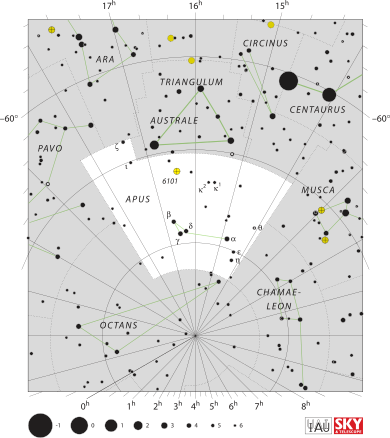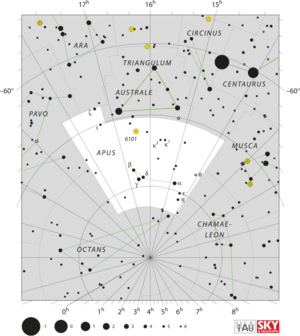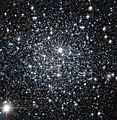Apus facts for kids
| Constellation | |

|
|
| Abbreviation | Aps |
|---|---|
| Genitive | Apodis |
| Pronunciation | genitive |
| Symbolism | The Bird-of-Paradise |
| Right ascension | 16 |
| Declination | −75 |
| Quadrant | SQ3 |
| Area | 206 sq. deg. (67th) |
| Main stars | 4 |
| Bayer/Flamsteed stars |
12 |
| Stars with planets | 2 |
| Stars brighter than 3.00m | 0 |
| Stars within 10.00 pc (32.62 ly) | 0 |
| Brightest star | α Aps (3.83m) |
| Messier objects | None |
| Meteor showers | None |
| Bordering constellations |
Triangulum Australe Circinus Musca Chamaeleon Octans Pavo Ara |
| Visible at latitudes between +5° and −90°. Best visible at 21:00 (9 p.m.) during the month of July. |
|
Apus is a small constellation located in the southern part of the sky. It's not one of the brightest constellations, so it can be a bit tricky to spot. Apus is known as the "Bird-of-Paradise" constellation.
Contents
What is Apus?
Apus is a constellation that was first mapped by Dutch explorers in the late 1500s. It's part of a group of constellations known as the "Bayer Family," named after the astronomer Johann Bayer who helped map the southern sky.
The Name "Apus"
The word "Apus" comes from the Greek words meaning "no feet." This unusual name was chosen because the constellation represents a Bird-of-Paradise. In the past, people believed that these beautiful birds did not have feet and floated in the air.
Finding Apus in the Sky
Apus is located in the third quadrant of the southern sky (SQ3). This means you can only see it from the Southern Hemisphere or very close to the equator. It's surrounded by other constellations like Triangulum Australe, Circinus, Musca, Chamaeleon, Octans, Pavo, and Ara. The best time to look for Apus is in July.
Stars in Apus
Even though Apus isn't very bright, it has some interesting stars.
- The brightest star in Apus is called Alpha Apodis (α Aps). It has a brightness of about 3.83 magnitude.
- There are 12 stars that are visible to the naked eye under good conditions.
- Astronomers have also found two stars in Apus that have planets orbiting them, similar to our own Sun.
- The closest star to us in Apus is HD 128400, which is about 66.36 light-years away.
Images for kids
-
Detail of Johann Bayer's 1603 Uranometria, showing the constellations Apus, Chamaeleon, Musca (as "Apis", the Bee), and Triangulum Australe, as well as the South celestial pole.
-
Globular cluster IC 4499 taken by Hubble Space Telescope.
See also
 In Spanish: Apus para niños
In Spanish: Apus para niños




